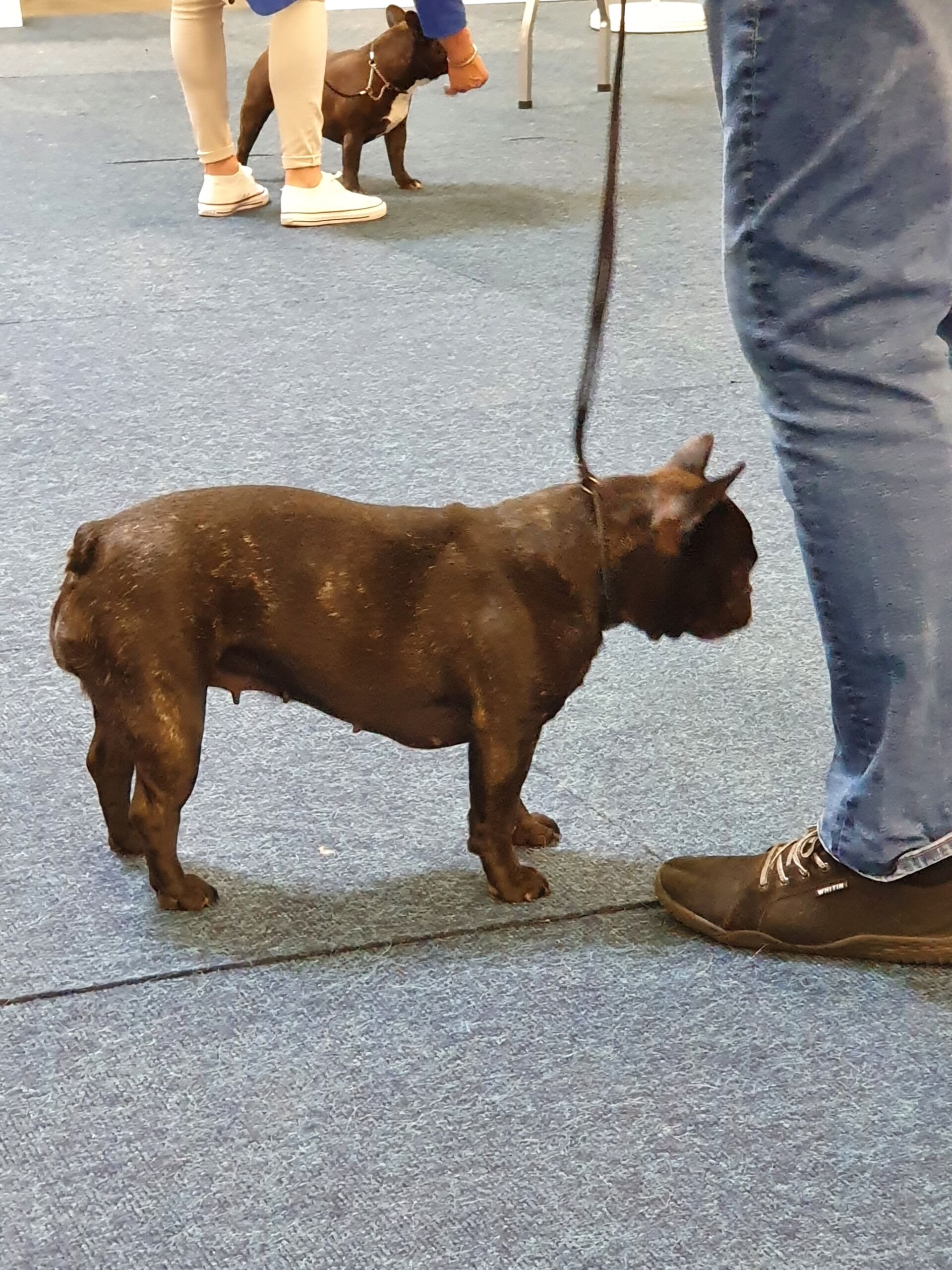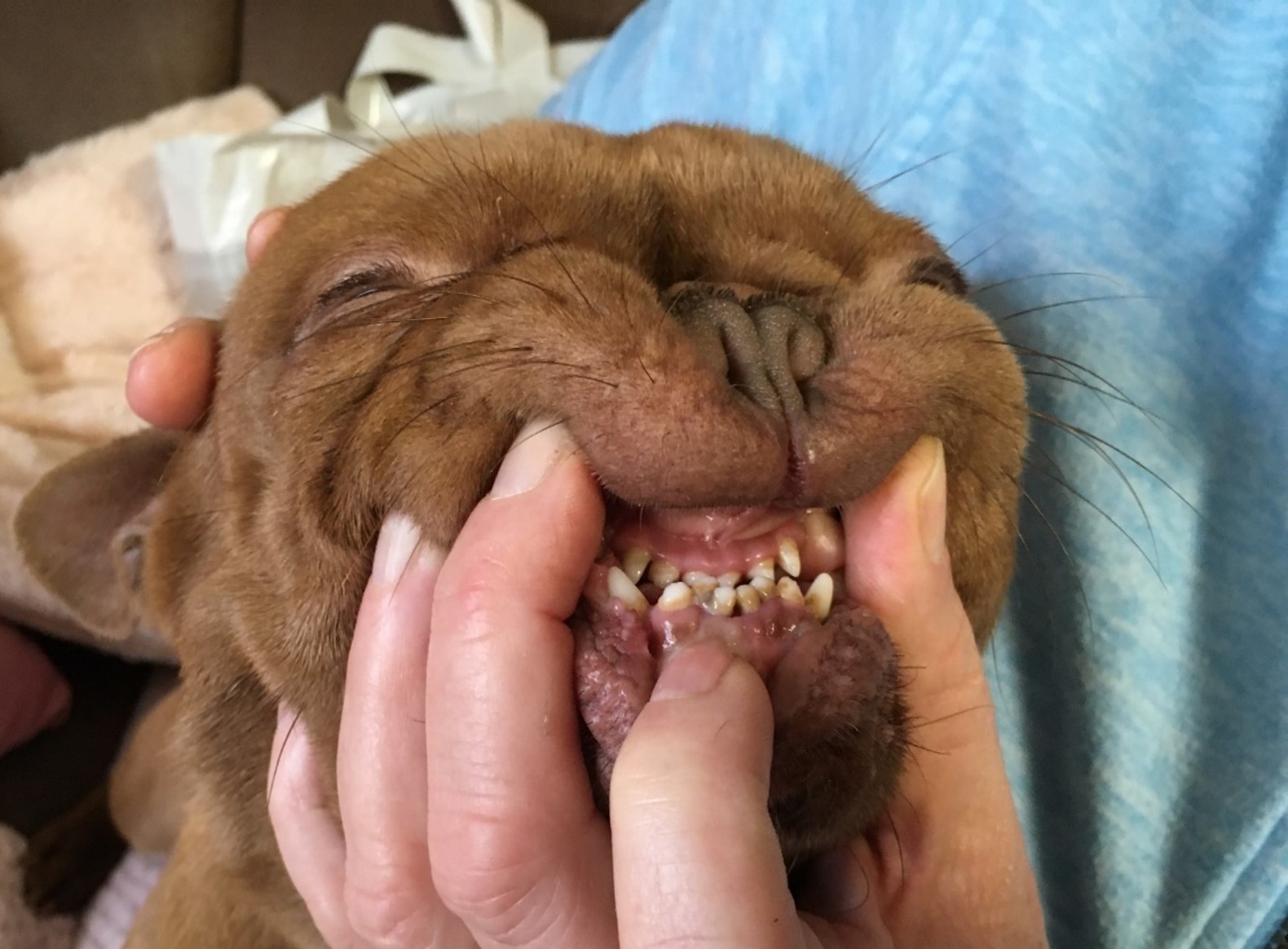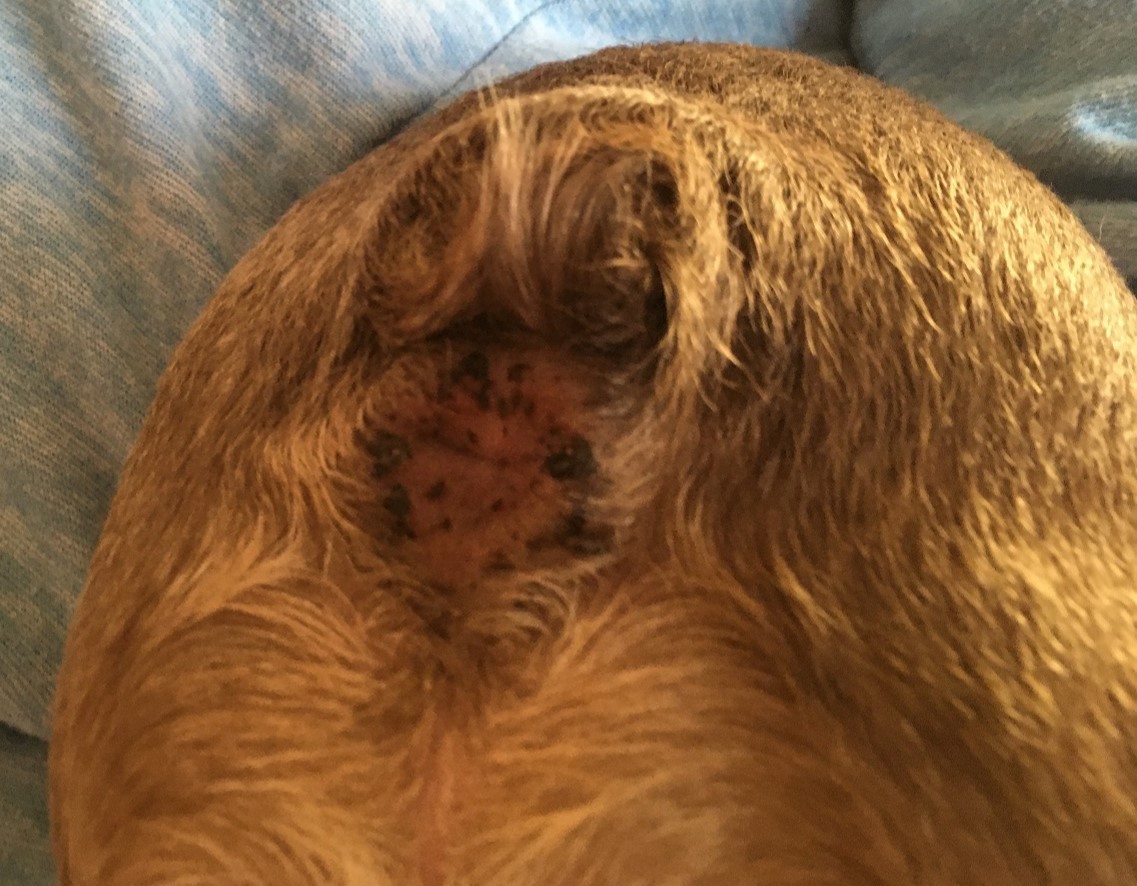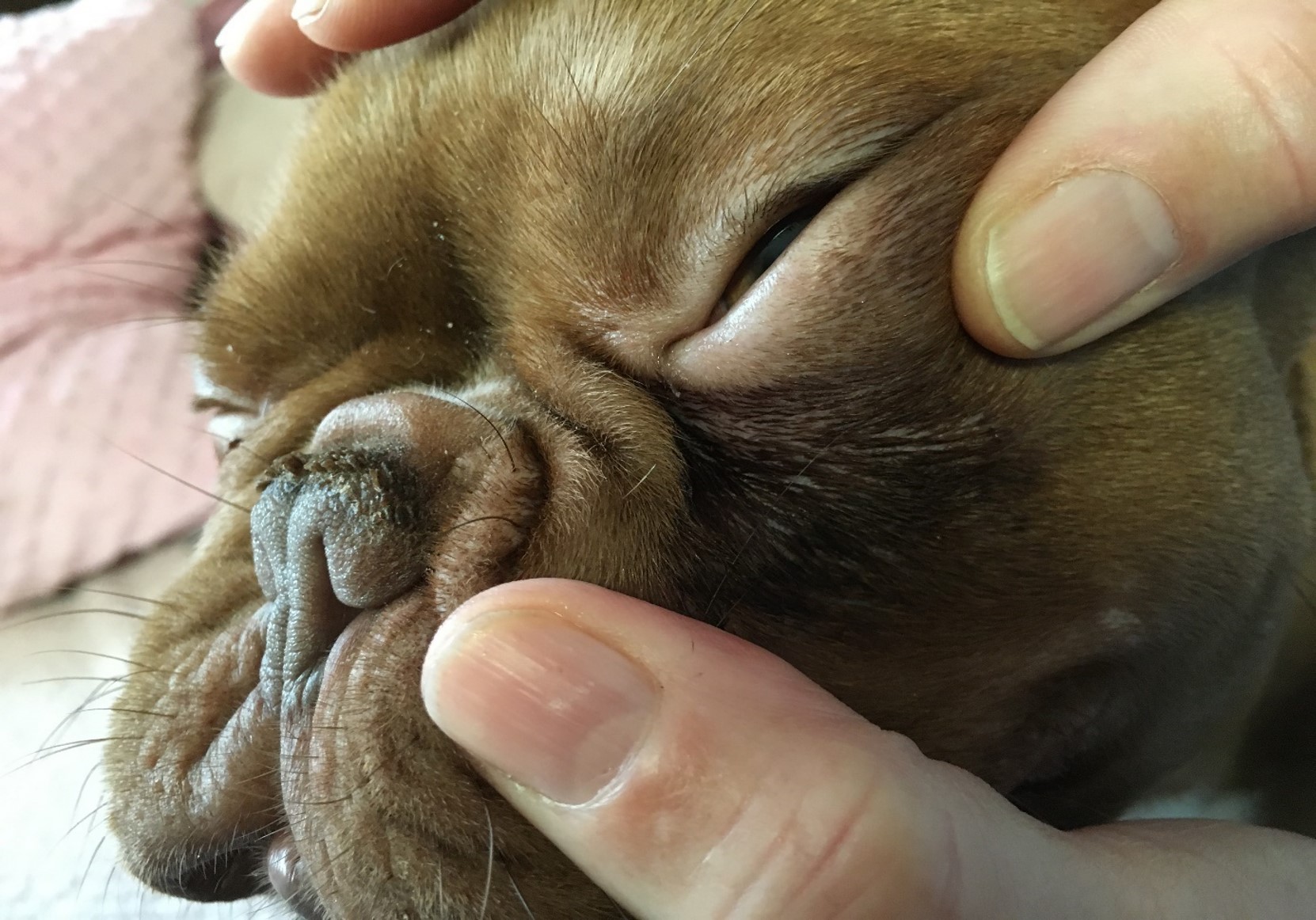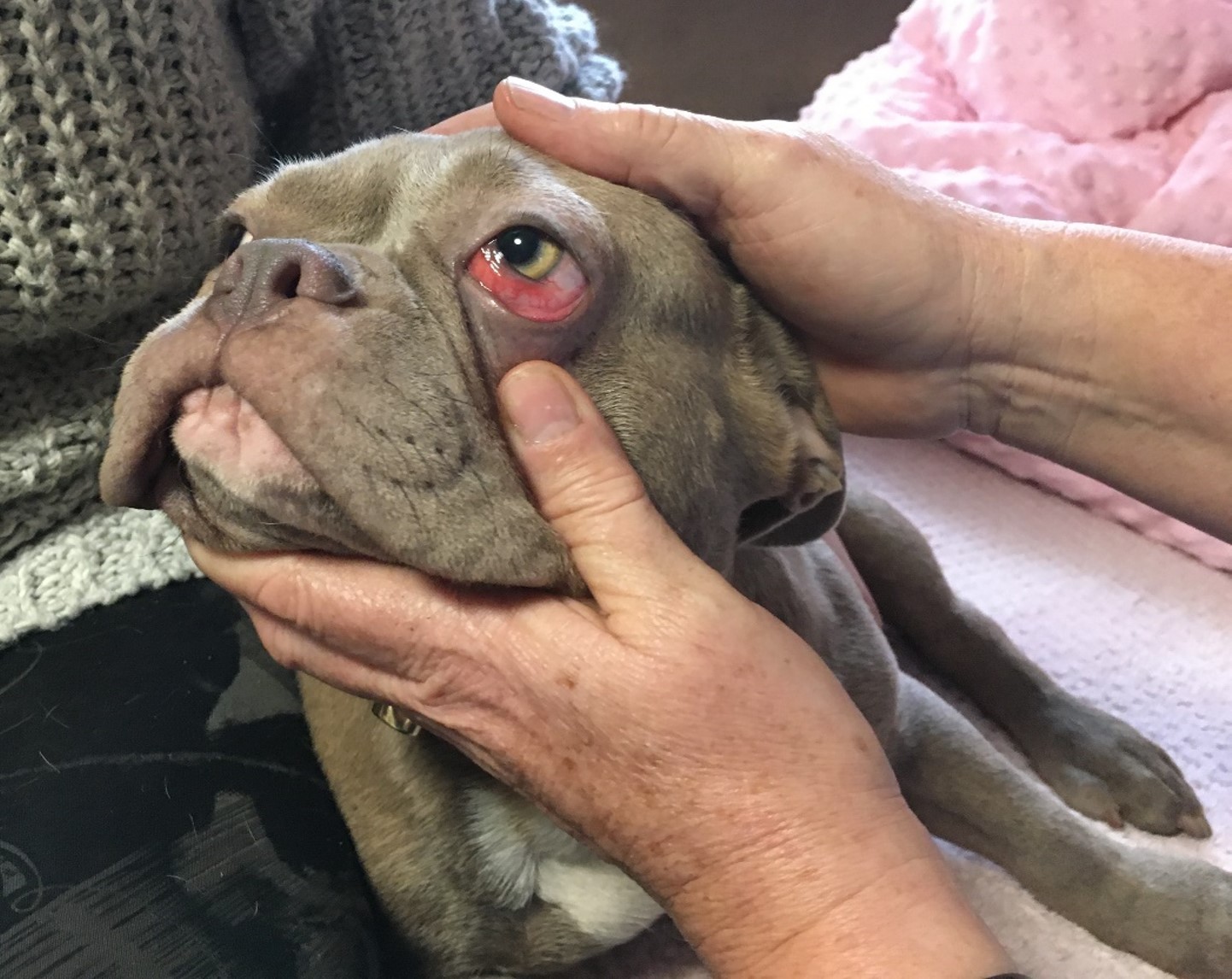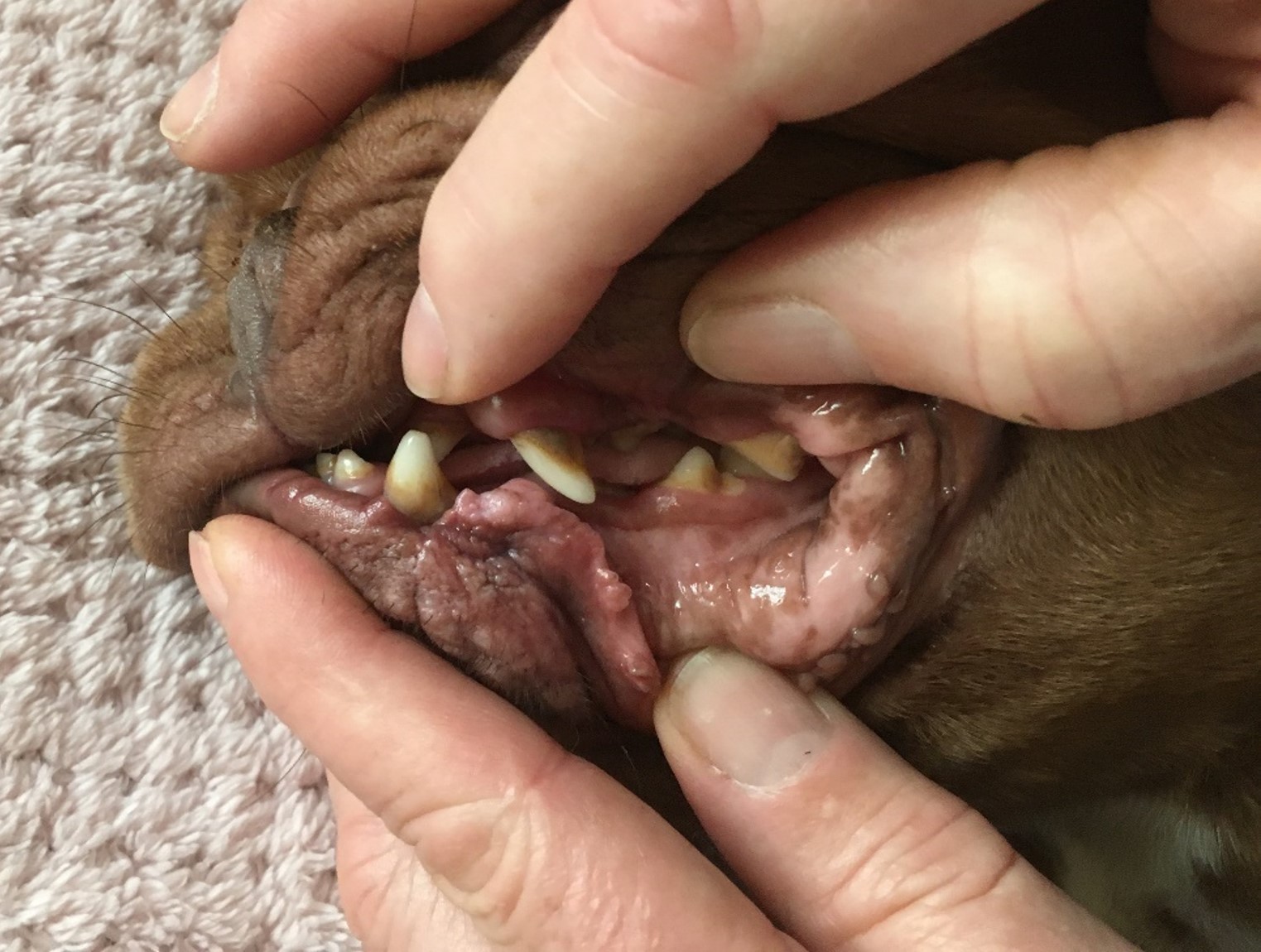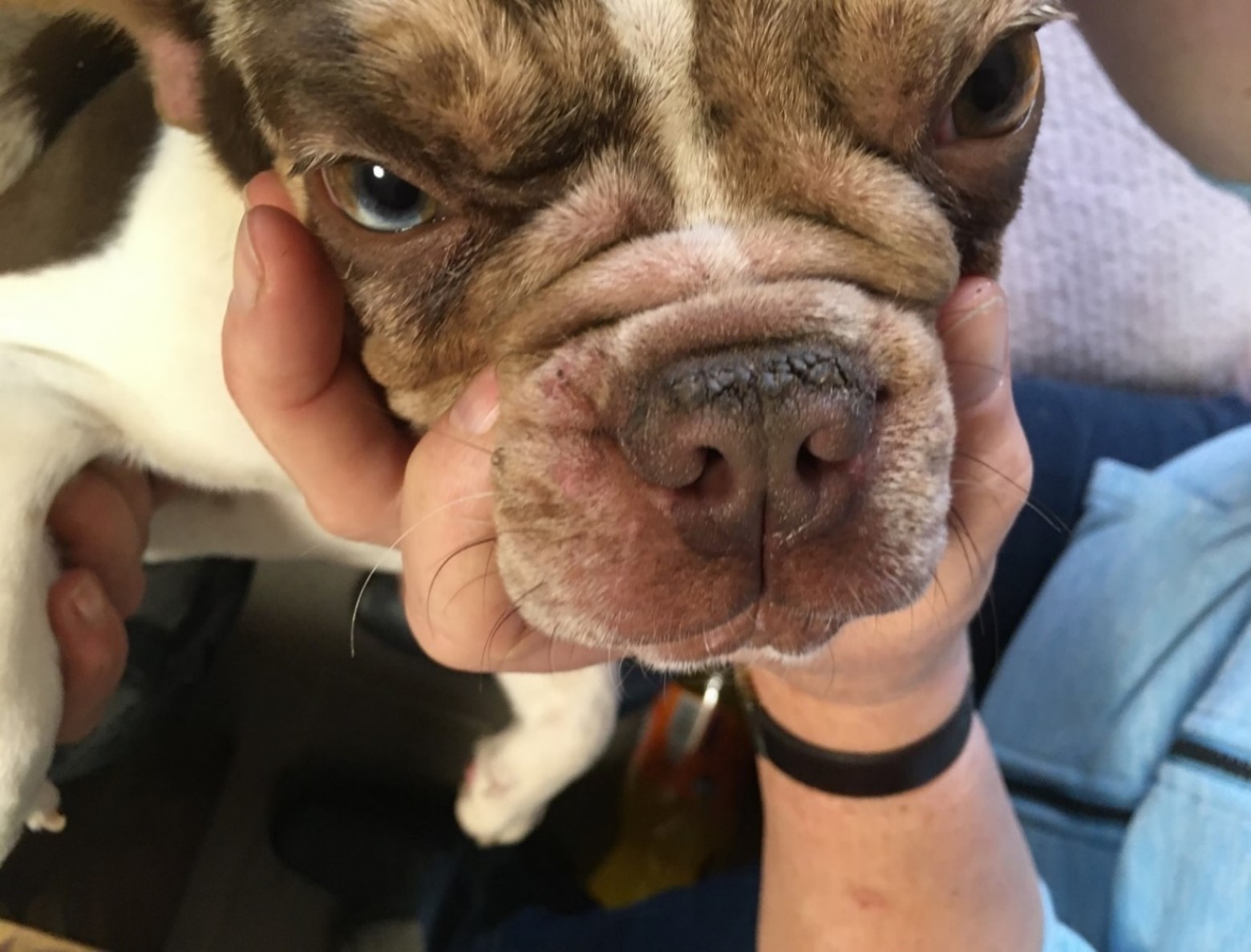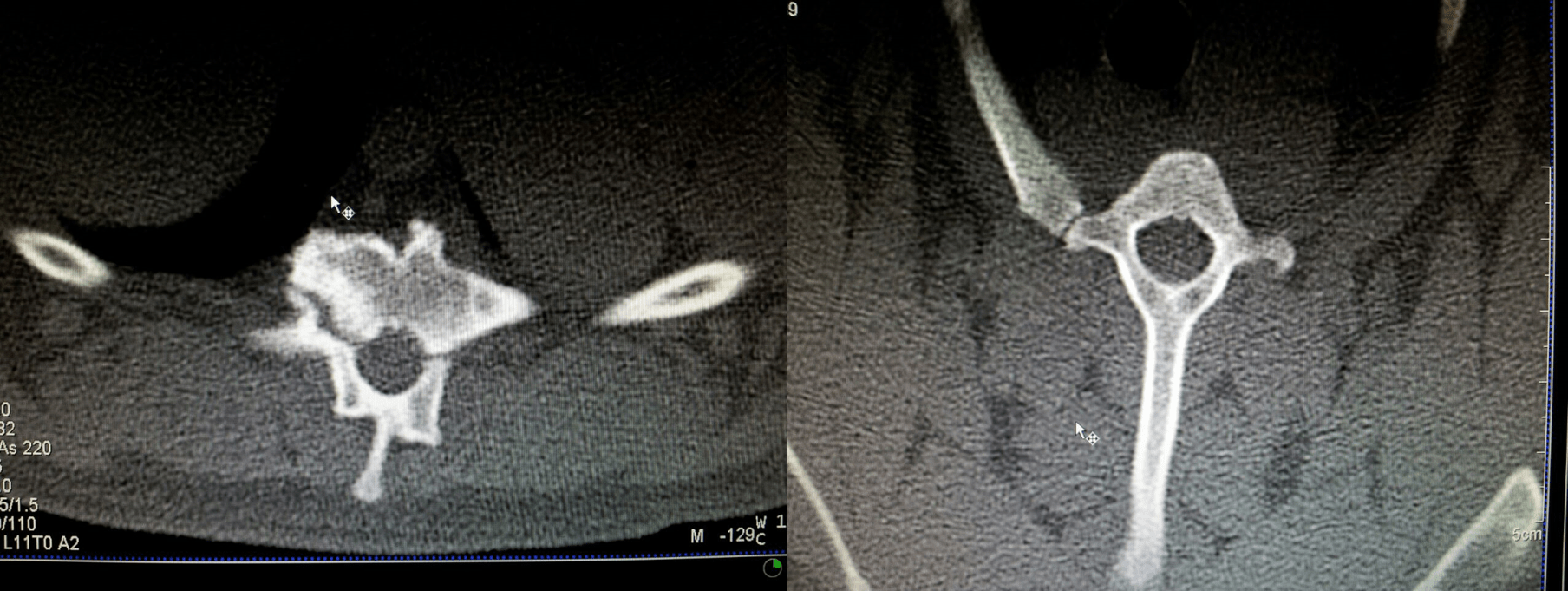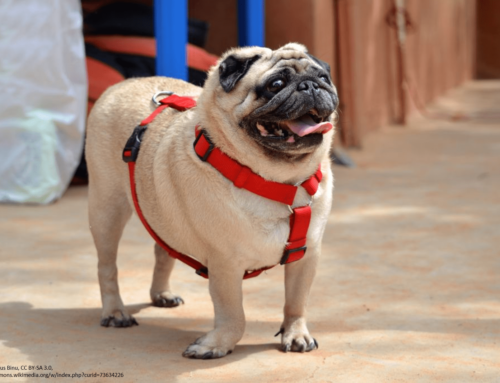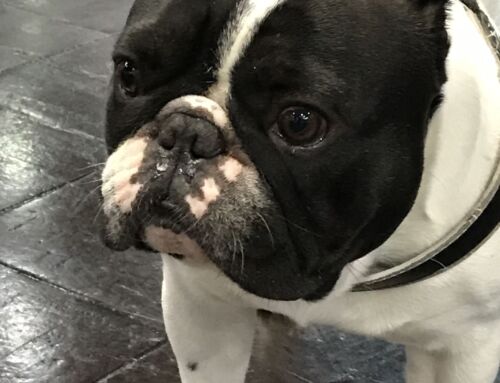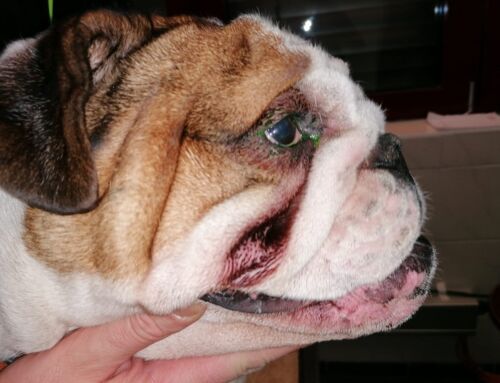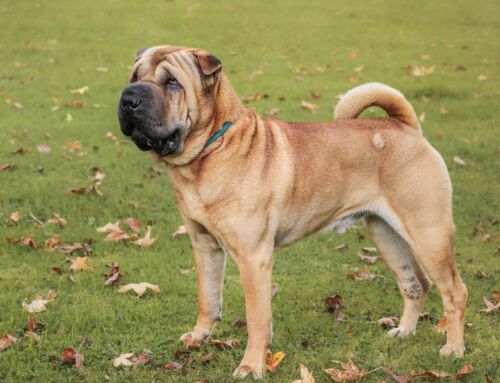Fact Sheet Dog Breed French Bulldog
Species: Dog
Breed: French Bulldog
QUEN-Fact Sheet Nr. 23-EN
Status: 23.05.2024
Species: Dog
Breed: French Bulldog
QUEN-Fact Sheet Nr. 23-EN
Status: 23.05.2024
1. Description of the animals
FCI breed standard* Nr. 101
https://www.fci.be/Nomenclature/Standards/101g09-en.pdf
External appearance and critical characteristics required by the standard:
According to the FCI breed standard, the French Bulldog should be a small-sized Molossian with a strong, short and stocky build, a snub-nosed face and prick ears. A „natural short tail“ is mentioned. Furthermore it should be a lively, alert, very muscular dog.
Already many characteristics demanded in the breed standard cause relevant animal welfare issues like the body shape, the length of the nose, which should be proportionally about 1/6 of the total length of the head and the missing, much too short or crippled tail (see below Robinow-like syndrome).
The breed is bred in various smaller and larger breeding associations, within and outside the large umbrella associations.
- In Germany the TierSchG and the TierSchHuV are legally binding for the assessment of the individual animal.
2.1 Picture 1
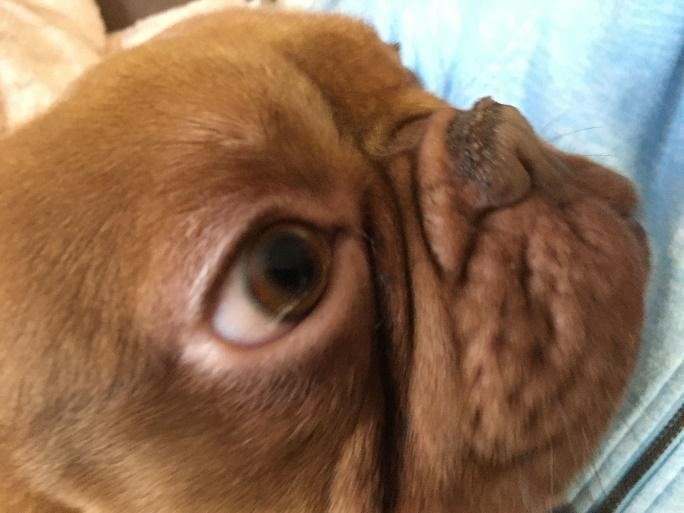
French Bulldog.
Picture: QUEN-Archiv
2.1 Picture 2

French Bulldog
Picture: QUEN-Archiv
More pictures can be found here (click on picture):
3. Problems/syndromes that may occur in the breed
The following common problems/health disorders and dispositions are known to occur in the French Bulldog breed:
(Please also refer to the existing fact sheets on defects of individual body parts, in particular Robinow-like syndrome, brachycephaly, tail, BOAS*, entropion).
*is currently being processed.
- Robinow-like syndrome with defects of the head, spine and tail
- Brachycephaly: Nose length less than ⅓ of the skull length (see traffic light system NL)
- Brachycephalic obstructive airway syndrome (BOAS) and BOAS-associated, pressure-related reflux gastritis/esophagitis problems and resulting gastrointestinal inflammation
- Spinal column/vertebral body malformations: Wedge, block and butterfly vertebrae, Intervertebral disc damage (IVDD)
- Dystocia: more frequent caesarean births due to feto-pelvic disproportion
- Skin diseases: „tail-fold dermatitis“, intertrigo
- Diseases of the eyes: e.g. entropion, cherry eye, exophthalmos, conjunctivitis
- Ear diseases: Otitis externa, stenosis of the external auditory canal and middle ear with or without otitis media
4. Other problems that may occur frequently
In addition to the breed-typical defects listed under point 3, the veterinary literature also contains information on the occurrence of the following problems, which are not described further below, as it is not yet possible to draw any definitive conclusions on prevalence:
- Arachnoid cysts
- Atopy/feed allergy
- Cystinuria
- Degenerative myelopathy
- Demodicosis
- Ectropion
- Elbow dysplasia
- Hiatal hernia
- Cataract
- Heart disease
- Hip dysplasia
- Low life expectancy (Switzerland)
- Nasal parakeratosis
- Patellar luxation
- Pulmonary stenosis
- Tumor diseases
5. Clinical signs and disease value of the typical defects mentioned above: Significance/impact on the physical/psychological well-being (burden) of the defect in the individual animal and classification in a burden category*
*The individual breeding-related defects are assigned to different burden categories (BC) depending on their severity. The overall burden category is based on the most severe defect found in the individual animal. The BC system as a further development based on the Swiss model is still being developed and is only intended as a guide. For this reason, the BC values used here should be regarded as provisional. This is primarily due to the fact that the German Animal Welfare Act does not contain a justiciable basis for classification into burden categories. In contrast to Switzerland, the legal standards in Germany do not quantify pain, suffering or harm or assess their quality, but take them into account if they affect the animal more than insignificantly.
The burden that can be caused by defective breeding traits are divided into 4 categories (Art. 3 TSchZV, Switzerland). The most burdenful trait or symptom is decisive for the assignment of an animal to a burden category (Art. 4 TSchZV, Switzerland).
Category 0 (no contamination): These animals may be used for breeding.
Category 1 (mild burden): Mild burden is present if a burdenful expression of characteristics and symptoms in pets and farm animals can be compensated for by appropriate care, husbandry or feeding, without interventions on the animal and without regular medical care measures.
Category 2 (medium burden): These animals may only be used for breeding if the breeding objective is for the offspring to be less burdened than the parents.
Category 3 (severe burden): These animals may not be used for breeding.
Robinow-like syndrome
(see also fact sheet no. 24 Dog Robinow-Like Syndrome) https://qualzucht-datenbank.eu/merkblatt-hund-robinow-like-syndrom/)
Physical:
The syndrome is associated with shortened limbs and various anomalies. Particularly noticeable are malformations of the skull and vertebral bodies. The skull is very broad and the face is flattened. This is associated with a particularly short hard palate and a shortened skull base with a regular size of the soft palate, which results in a disproportion of the soft tissue structures within the skull. Vertebral malformations such as block vertebrae, dorso-lateral hemivertebrae, lateral hemivertebrae, butterfly vertebrae, wedge vertebrae, transitional vertebrae, spondylosis and abnormally shortened vertebrae are also associated with this characteristic. Malformed, fused or missing caudal vertebrae can lead to a shortened or so-called corkscrew tail. As a rule, anatomical malformations in various organs lead to restrictions in various bodily functions such as breathing, thermoregulation, defecation, reproduction (mating, birth), movement, neurological disorders and impaired vision and hearing (due to otitis media).
Psychological:
Suffering due to restricted communication: facial wrinkles, severely shortened muzzle, reduced to non-functional, shortened tail.
(see also https://qualzucht-datenbank.eu/merkblatt-hund-rute/ and https://qualzucht-datenbank.eu/merkblatt-hund-brachycephalie/)
Pain and suffering, e.g. in the case of intervertebral disc damage due to the consequences of anatomical deformities and anxiety, e.g. in the case of respiratory distress syndrome. Respiratory distress leads to anxiety and is classified as a severe condition. This state of anxiety is exacerbated by insomnia caused by breathlessness.
Burden category: 3 with pure genotype
Brachycephaly
(see also fact sheet no. 8 Dog Brachycephaly https://qualzucht-datenbank.eu/merkblatt-hund-brachycephalie/)
Physical:
Brachycephaly describes in the broadest sense the shortening of the head, including the muzzle. The special anatomy of the upper airways in brachycephalic dogs leads to obstruction of the upper airways. Compared to other breeds, brachycephalic dogs have a shortened skull, resulting in a compressed nasal passage and altered pharyngeal anatomy. When comparing CT images of normocephalic dogs and selected brachycephalic breeds, the significantly shortened nasal cavity is striking. However, the intranasal structures such as the turbinates are not necessarily shortened, so that they can deviate from their physiological position and obstruct the respiratory tract. The cross-sectional areas of various parts of the upper airways are significantly reduced. In addition, the breed often has nasopharyngeal turbinates (nasal turbinates are bony lamellae covered with nasal mucosa that protrude from the lateral nasal wall into the nasal cavity). Above all, caudal abnormal turbinates can affect more than half of the French Bulldogs examined (65.5%). Most brachycephalic dogs have a combination of compressed anatomical structures that create increased negative pressure on inspiration, leading to inflammation and stretching of the pharyngeal tissues and obstruction. The anatomical changes and malformations of the bony skull could also be a cause of the narrowing of the ear canal. Compared to other dog breeds, brachycephalic dogs often exhibit macroglossia. There is no difference in volume between affected and healthy dogs, but the tongue is larger in relation to the reduced size of the skull and also impairs breathing.
The nasolacrimal duct is very often malformed due to breeding-related changes to the facial skull and its course is very different. It is often considerably reduced in length and can be very steep. This leads to a partial or complete obstruction of the canal, so that tear fluid drains to the outside (via the eyes). An indication of this defect is a „tear duct“ with brownish discoloration of the coat, which often leads to dermatitis if it runs in a fold at the same time. In many cases, the nasolacrimal ducts of affected animals have an additional opening through which the fluid can also drain into the posterior part of the nasal cavity.
Studies show differences in the cardiac ECG between brachycephalic dogs and dogs without brachycephaly. In brachycephalic dogs, the diastolic pressure in the right heart appears to be increased, which impairs the function of the heart. The changes in cardiac morphology and function are usually due to the anatomical changes, not the appearance of symptoms associated with brachycephaly. The changes in the bony skull can also cause changes, diseases and an increased risk of injury to the eyes.
Brachycephaly is also associated with a malformation (brachygnathia superior), which often leads to changes in the dentition, such as malocclusion.
Psychological:
Extreme cases of brachycephaly are associated with a variety of pathologies affecting all life stages and different organ systems. A study from the UK (2020) provides clear evidence that brachycephalic breeds are generally less healthy than non-brachycephalic dog breeds. The animals are severely restricted in their natural behavior in many areas of life, so that a reduced quality of life can be assumed. For example, the puppies may not be forked off during birth, affected dogs may be unable to bite fleas or to eat due to regurgitation and choking. The life expectancy of brachycephalic breeds, such as the French Bulldog, is significantly reduced compared to breeds with mesocephalic head shapes, for example.
A physiological and species-appropriate life is no longer possible, as affected animals are exposed to the lifelong fear of suffocating. This is reflected in the many compensatory mechanisms that such dogs have adopted in order to survive. Lying flat on cool surfaces to cool the whole body and stretching the neck when sleeping are just two of these symptoms. Even if affected animals adapt their behavior to the situation (get used to it), it still restricts their quality of life.
Affected dogs are extremely restricted in their communication with other dogs and also in their grooming due to the corresponding vocalizations (rattling, coughing, heavy breathing), which are often misinterpreted as growling by other dogs, as well as the physiological conditions (bulging eyes, wrinkled face, missing tail, short back).
Burden category: 3
BOAS (brachycephalic obstructive airway syndrome incl. tracheal hypoplasia)
Physical:
In a study by Packer et al. (2015), up to 70% of French Bulldogs were affected by BOAS and they were among the most affected breeds of all. The anatomical and physiological changes caused by brachycephaly affect the airway and respiratory function. The skull is shortened due to brachycephaly, but the soft connective tissue structures inside have not reduced in volume accordingly and so the anatomical structures are compressed due to sheer lack of space. The animals often show stridor, inspiratory dyspnea, cough, cyanosis, exercise intolerance and an increased risk of hyperthermia due to impaired thermoregulation. The symptoms can lead to death. Characteristic changes include stenotic nostrils and thickening and elongation of the soft palate. The mucous membrane of the concha hypertrophies and further impedes breathing. Due to the deformities in the nasal/mouth/throat area, the animals have to fight against a much higher breathing resistance. Nasal mucosal contact points, which restrict the transportation of air, exacerbate the breathing problems. Panting or tachypnea in states of excitement or heat stress cause the connective tissue structures within the airways to swell. Increased exertion on the part of the dog and the resulting worsening of the obstructions are mutually beneficial. This can lead to secondary diseases of the larynx, such as mucosal edema and laryngeal collapse. Snoring noises are common in these dogs. If the clinical symptoms are severe, the animals must be treated with intubation, oxygen, cooling and/or sedation. Upper airway obstruction can lead to further secondary complications such as aspiration pneumonia and non-cardiac pulmonary edema. The lower airways are also affected by changes in BOAS due to the increased airway resistance in the upper airways. Collapsed bronchi, retching, increased salivation, regurgitation, vomiting, esophageal motility disorders and dysphagia may occur. Endoscopic and histological examinations revealed changes in the esophagus, stomach and duodenum.
Psychological:
Physiological breathing is severely impaired, so that the animals often suffer from dyspnoea or respiratory distress. The animals suffer from chronic respiratory distress and are forced to breathe mainly through the open mouth. Heat stress and limited activity due to exercise intolerance restrict the dogs in their species-typical behavior. They are more susceptible to stress and excitement. Particularly at high outside temperatures, the animals‘ activity is especially restricted due to impaired thermoregulation. Affected dogs suffer from sleep apnoea, restless sleep and change their sleeping behavior, such as adopting an upright sleeping position or sleeping with an object in their mouth, in order to prevent obstruction of the airways. The various aspects of impaired breathing, sleeping behavior, activity and gastroenterological symptoms have a negative impact on the animal’s well-being. A species-appropriate life is hardly possible for the affected dogs. This is reflected in the various compensatory mechanisms that such dogs have adopted in order to survive.
Burden category: 3
Vertebral body malformations and tail deformation
(See also fact sheet no. 5 Dog Tail https://qualzucht-datenbank.eu/merkblatt-hund-rute/)
Physical:
Typically, a shortened and possibly twisted tail („screw tail“) occurs as a result of malformations and fusions of the vertebral bodies. This is often accompanied by other deformities of the spinal column. The diagnosis of vertebral anomalies is usually accidental. The malformations can lead to incorrect curvatures of the spine such as kyphosis, lordosis or scoliosis. The malformations of the vertebral bodies can cause constrictions in the central canal, which can compress the spinal cord and cause neurological impairments. In addition to pain and various paresis and plegia, this also includes muscle atrophy and incontinence of feces and/or urine. Congenital malformations of the thoracic vertebrae are frequently observed in French Bulldogs. Mostly wedge vertebrae, but also shortened vertebrae, butterfly vertebrae and hemivertebrae occur. Symptoms of thoracic hemivertebrae may include paresis and ataxia of the hind limbs, paraplegia, spinal hyperesthesia and urinary and fecal incontinence. Usually several hemivertebrae occur simultaneously in one dog.
Chondrodystrophic breeds, such as the French Bulldog, also show frequent (degenerative) changes in the intervertebral discs.
Formulations in the breed standard that can be problematic even without over-typing, such as the tolerance of a so-called „corkscrew tail“ „TAIL: …A knotted, kinked tail or a relatively long tail that does not protrude beyond the hock is permitted“ arise from a complete lack of understanding of the situation: corkscrew tails (due to Robinow-like syndrome, caused by a genetic variant in the DVL2 gene) are associated with malformations of the spine and favor the development of inflammation of the skin in the skin folds.
Psychological:
Disc diseases and deformities of the spine are usually accompanied by pain and various neurological deficits and paralysis, which significantly impair well-being and quality of life. A corkscrew tail or a tail that is missing all but a few vertebrae can hardly or no longer be used as a means of expressing the natural and species-appropriate behavioral repertoire. Dogs are no longer able to reach body orifices (anus and especially the female genitals) or cover them with their tail and thus protect themselves or lift their tail sufficiently when defecating.
Restrictions in the behavioral repertoire are recognized as suffering.
Burden category: 3
Birth difficulties (dystocia)
Physical:
Brachycephalic breeds, such as French Bulldogs, are overrepresented in dystocia (labor weakness). The reason for this is usually the disproportion between the pelvis of the mother dog, the size of the puppies‘ heads and the width of the puppies‘ shoulders (feto-pelvic disproportion). This is also reflected in the percentage rate of caesarean sections. It is reported that a caesarean section has to be performed in over 80% of births. These are often emergency caesarean sections. This alone represents an increased health risk, for example due to anesthetic incidents.
Psychological:
It must be assumed that the majority of French Bulldogs can only be born by means of surgical intervention (caesarean section). A caesarean section can influence maternal behavior. Vaginocervical stimulation appears to play an important role in maternal behavior, as it has been observed that females born by caesarean section may have problems developing adequate interactions with their puppies without the induction of a natural birth. Even with a natural birth, brachycephalic animals often have problems opening the amniotic sacs and biting the umbilical cord due to the shape of the skull and dentition, which increases the risk of problems.
Burden category: 3
Skin diseases (bacterial folliculitis, dermatitis and pyoderma due to skin folds, tail fold intertrigo, demodicosis, nasodigital hyperkeratosis)
Physical:
French Bulldogs are predisposed to various skin diseases, such as dermatitis in the skin folds (intertrigo), interdigital pyoderma and demodicosis. The shortening of the skull results in skin folds in the area of the muzzle, eyes and ears. Tail fold intertrigo is a special form in breeds with a shortened or crippled tail („screw tail“). The French Bulldog is particularly frequently affected. This disease usually requires surgical treatment with removal of the crippled vertebra and the surrounding skin folds.
Bacterial folliculitis is often caused by S. pseudointermedius. The pathogens invade due to internal or external damage to the skin and cause changes at the corresponding site. Clinically, small inflammatory papules and pustules with a central hair shaft appear. The lesions often go unnoticed until hair loss occurs.
Psychological:
Affected animals suffer from itching and pain, and the symptoms often have to be monitored and treated for the rest of the dog’s life. Regular veterinary interventions are usually necessary and cause the dog additional stress.
Burden category: 2-3
Eye diseases
Physical:
Brachycephalic breeds such as the French Bulldog have anatomical skull changes that are responsible for various eye diseases and are summarized under the term brachycephalic ocular syndrome (BOS). Excessive selection pressure leads to extreme skull shapes and can endanger the dogs‘ eyesight.
The French Bulldog has a disproportionately high incidence of eye diseases. Many eye diseases are associated with the brachycephalic phenotype of the animals. The round head and flat orbit favor a certain degree of exophthalmos. In combination with a wide palpebral fissure (macroblepharon), eyelid closure and lubrication of the eye are restricted. Entropion is also frequently diagnosed. Incomplete closure of the eyelid impairs blinking and therefore eye health and lubrication. This can promote other diseases such as keratitis and keratoconjunctivitis sicca. A nictitating membrane prolapse („cherry eye“) can also be observed in the French Bulldog and occurred in studies in approx. 76% of affected animals before the first year of life. Ulcerative diseases of the cornea can occur frequently with a prevalence of 1.87%. It is suspected that the reduced sensitivity and innervation of the cornea associated with brachycephaly could be a predisposing factor. Another risk factor for ulcerative changes of the cornea are skin folds extending over the nose. They themselves or hair growing on them can rub against the cornea and lead to traumatic keratitis and ulceration.
Psychological:
The constantly affected conjunctiva and corneal surface (because it is too dry or irritated by the eyelid being rolled inwards) causes chronic pain in the dog, which leads to a permanent impairment of well-being. Impaired eyelid closure and blinking affect behavior and prevent the animal from protecting itself from external stimuli. Nociceptive afferent nerve cells innervate the cornea, so it can be assumed that ulcerative changes can cause considerable pain and also impair vision. The changes can have a strong influence on the well-being of the animals, as they can lead to pain, uveitis and perforation or even loss of the eye.
Burden category: 2-3
Ear diseases
Physical:
French Bulldogs are predisposed to ear diseases due to their brachycephalic head shape. The ear canal is significantly narrower compared to non-brachycephalic breeds. The bulla tympanica is significantly thickened and less voluminous. These changes in the external auditory canal and middle ear can lead to tympanic cavity effusions and otitis due to secondary infections. Affected dogs often suffer from significantly impaired hearing. Examination by the vet is almost impossible when the dog is awake, as affected dogs have a highly constricted auditory canal.
Psychological:
Reduced hearing limits the dog’s sensory performance and its ability to absorb stimuli from the environment and communicate with its bonding partner, humans and conspecifics, and can lead to insecurity. In addition, the dog must compensate for this deficiency in other ways.
Burden category: 2-3
In the French Bulldog, the breed-related (standard-related) initial values already result in the overall category 3.
6. Heredity, genetics, known gene tests, if applicable, average coefficient of inbreeding for the breed (COI), if applicable, Generic Illness Severity Index
Shortening of the facial skull and associated problems with thermoregulation, ear diseases, meat-in-the-box syndrome, etc.
The shortening of the facial skull is due to massive selection in breeding practice, i.e. it is genetically determined and consists of several components.
Robinow-like syndrome
A genetic variant of the DVL2 gene has been identified that is fixed in French Bulldogs, English Bulldogs and Boston Terriers and is associated with the breed-typical phenotype. This variant correlates with chest and tail vertebrae malformations and, together with the already known variants in the SMCO2 and BMP3 genes, contributes to the brachycephalic phenotype. The variant appears to follow an autosomal recessive pattern of inheritance, showing incomplete penetrance with respect to thoracic vertebral malformations, which differs from purebred individual to purebred individual. However, evidence that the DVL2 variant may also be linked to other health problems such as brachycephalic obstructive airway syndrome (BOAS) or congenital heart defects is still the subject of ongoing research.
Genetic test: A genetic test for the DVL2 gene is available.
Brachycephaly (shortening of the facial skull and associated problems with thermoregulation, ear disorders, etc):
Genetics and inheritance are not fully understood. Due to the genetic complexity, it is assumed that various chromosomes have an influence. It is assumed that the TCOF1 gene is involved in the development of brachycephaly. This assumption has not been confirmed. Several studies found correlations with the CFA1 gene, which contains loci associated with brachycephaly. The involvement of SMOC2, BMP3, FGFR-2, THBS1 and DVL2 genes has also been discussed.
Other genetic tests available for the breed (as of May 2024)
Canine multifocal retinopathy (CMR1)
Chondrodysplasia (CDPA) and -dystrophy (CDDY) (IVDD risk)
Congenital hypothyroidism (CHG)
Cystinuria
Degenerative myelopathy (DM exon2)
Hereditary cataract (HSF4)
Hyperuricosia
Lafora epilepsy
Malignant hyperthermia
Progressive retinal atrophy (cord1 and prcd)
Robinow-like syndrome
Average inbreeding coefficient of the breed
The average degree of inbreeding in French Bulldogs was already around 28% in 2016. A sibling cross produces 25% inbreeding. These data therefore show that the average breeding is the genetic equivalent of a full sibling cross. A population that produces mainly healthy animals would have an inbreeding rate of around 5% or less. It is expected that genetic diseases and health losses will occur at an inbreeding level of more than about 10%.
7. Diagnosis – Necessary examinations before breeding or exhibition
Robinow-like syndrome
Suspected diagnosis based on breed affiliation/pathognomonic phenotype; confirmation by genetic testing if necessary. If the DVL2 variant is detected in the homozygous or heterozygous state, there is no need for further X-ray or CT examinations in otherwise symptom-free (not trait-free) dogs, as these animals may not be exhibited or bred with anyway.
French Bulldogs have a broad head, a short muzzle, widely spaced eyes and anomalies of the vertebral bones and tail. They have shortened and possibly kinked tails („screw-tail“) as an easily recognizable feature.
In this respect, the appearance of the animals due to the visible damage already justifies the show ban and additionally the suspicion of the presence of Robinow-like syndrome, which can be verified by a genetic test.
Brachycephaly
In borderline cases, the expression of the trait can only be partially diagnosed by external observation and examination, unless clear, externally visible defects already allow sufficient assessment. Further specialist veterinary examinations, imaging procedures to examine the head and, in some animals, the skeletal system, verify the diagnosis, complete the overall picture and may be necessary to provide the animal with any necessary medical treatment. Endoscopy can be used to detect stenoses, constrictions in the nasal vestibule, excess length and thickening of the soft palate, changes in the trachea and excessive tissue in the nasopharynx/muzzle. In addition to the changes in the shape of the head, nostrils and jaw that can already be determined by inspection, X-rays and/or a multidimensional imaging procedure (cranial CT) provide clarity. Methods for measuring the skull are also possible.
BOAS (brachycephalic obstructive airway obstruction syndrome, possibly including tracheal hypoplasia)
In stable patients, lung function should be checked by auscultation, pulse oximetry and blood gas analysis. Pneumonia and pulmonary edema can be diagnosed radiographically. An endoscopic examination is suitable for assessing the structures in the oral cavity (e.g. palate, larynx) and trachea. X-rays can be taken to diagnose tracheal hypoplasia. For a precise morphological examination, high-resolution imaging procedures such as a CT scan are necessary. The severity of the disease (BOAS) can also be assessed by means of an exercise test.
Esophageal motility disorders can be diagnosed using videofluoroscopy with barium.
Spinal defects
Changes in the tail can be seen and felt from the outside and are therefore easy to diagnose. Since a malformed tail occurs in a high percentage of cases in conjunction with other changes in the spine, a skeletal examination under anesthesia using multidimensional imaging techniques is useful and necessary.
The neurological examination serves as an initial assessment.
Ear diseases
The clinical examination, including adspection, can be supplemented by imaging procedures, such as a CT or MRI, in order to assess the internal structures of the ear. Bacterial cultures can be taken in the event of potential inflammation. Possible hearing loss/deafness due to extreme white coat colour or Merle factor is diagnosed by recording a functional auditory evoked potential.
Eye diseases (entropion, corneal ulcers, cherry eye)
The described eye diseases can be diagnosed by means of a complete ophthalmologic examination.
8. Necessary or possible orders from an animal welfare perspective
Decisions on breeding or exhibition bans should be made in connection with the burden category (BC). Depending on the severity and findings, the decisive factor for a breeding ban may be the most severe finding, i.e. the one that affects the animal the most, and its classification in one of the burden categories (BC), or also the assessment of the correlation if there are many individual breeding-related defects. The individual inbreeding coefficient of an animal and its status as a carrier of risk genes should also be taken into account.
a) orders that appear necessary
Breeding ban according to §11b TierSchG for animals with hereditary/breeding-related defects, in particular
- with changes to the skeletal system: head, spine, hips, pelvis, elbows
- with brachycephalic obstructive airway syndrome (BOAS)
- positive genetic test for Robinow-like syndrome. The DVL2 genotype must be evaluated in conjunction with the clinical picture.
- with extremely shortened upper jaw, malpositioned teeth (especially visible teeth with closed mouth) or malocclusion, absence of several molars
- with missing, non-functional, severely shortened, crippled tail („screw tail“)
Exhibition ban according to §10 TierSchHuV
b) possible orders
Order for permanent infertility (sterilization/castration) in accordance with 11b (2)
Please note:
Measures taken by the competent authority must be recognizably suitable for averting future harm to the animal concerned and/or its offspring. With regard to the type and depth of processing of orders and breeding bans, decisions are always made on a case-by-case basis at the discretion of the competent authority, taking into account the current legal standards and the circumstances found on site.
9. General assessment of animal welfare law
a) Germany
From a legal point of view, dogs with the defects/syndromes described above are classified as torture breeding in Germany in accordance with §11b TierSchG.
Justification:
According to §11b TierSchG, it is prohibited to breed vertebrate animals if breeding knowledge indicates that, as a result of breeding, the offspring or progeny will, among other things
- body parts or organs are missing for species-appropriate use due to hereditary reasons or are unsuitable or deformed, resulting in pain, suffering or damage (§ 11b Para. 1 No. 1 TierSchG) or
- the keeping is only possible with pain or avoidable suffering or leads to damage (§ 11b Para. 1 No. 2 c) TierSchG).
The breeding of French Bulldogs constitutes torturous breeding due to the single or multiple damages, pain and suffering described in detail in section 5:
- Damage to the spine and associated pain
- Eye diseases and associated pain and damage
- Skin diseases and associated pain and suffering
- Ear diseases and associated pain, damage and suffering
- Inability to bear offspring naturally
- Impairment of thermoregulation and associated suffering
- Anxiety caused by shortness of breath
- Suffering due to limited communication skills
– The prohibition applies regardless of the subjective facts, i.e. regardless of whether the breeder himself recognized or should have recognized the possibility of harmful consequences. Because of this objective standard of care, the breeder cannot invoke a lack of subjective knowledge or experience if the respective knowledge and experience can be expected from a careful breeder of the respective animal species. (see Hirt/Maisack/Moritz, Tierschutzgesetz, Kommentar 4th ed. 2023, § 11b TierSchG para. 6).
– Hereditary changes in the offspring are also foreseeable if it is uncertain whether they will only occur after a generation jump in later generations (cf. Goetschel in Kluge § 11b para. 14). It should be noted that a breeding ban does not only apply if animals are bred that themselves exhibit traits relevant to cruelty (trait carriers), but also if it is known or must be known that an animal used for breeding can pass on traits that can lead to one of the adverse changes in the offspring (carriers; in particular animals that have already produced damaged offspring; (Lorz/Metzger, Kommentar zum TierSchG § 11b para. 6 with further evidence).
– An important indication of a hereditary defect is that a disease or behavioral deviation occurs more frequently in related animals than in the overall population of the dog species. The fact that the breed or population has proven to be viable over a longer period of time is not an argument against damage (see Lorz/Metzger Kommentar zum TierSchG § 11b Rn. 9).
b) Austria
Dogs with the defects/syndromes described above are classified as torture breeding in Austria according to §5 TSchG
In particular, anyone who “ breeds in a way that is foreseeable to cause pain, suffering, harm or fear to the animal or its offspring (torture breeding), so that as a result of genetic abnormalities in particular one or more of the following clinical symptoms occur in the offspring not only temporarily with significant effects on their health or significantly impair physiological life courses or cause an increased risk of injury“ is in breach of Section 5 of the Austrian Animal Welfare Act.
The use of the word „in particular“ means that the traits and symptoms listed in §5 are a non-exhaustive list of examples and that defects other than those in the list may also be considered to be breeding traits.
Breeding with dogs that suffer from the following defects and the associated problems or are genetically predisposed to them is to be qualified as torture breeding, as the following symptoms listed in § 5 are realized: Shortening of the facial skull (e.g. respiratory distress, malformations of the dentition), changes or inflammation of the external auditory canal and middle ear (e.g. deafness, neurological symptoms), entropion (inflammation of the conjunctiva and/or cornea, blindness), vertebral body malformations and shortened tail (movement abnormalities), skin fold dermatitis (inflammation of the skin), severe births/cesarean sections.
The breeding of French Bulldogs already qualifies as torture breeding due to the fact that „it must be assumed with a high degree of probability that natural births are not possible“ (Österreich. TSchG, 2022).
c) Switzerland
Dogs with defects that can be assigned to burden category 3, are subject to a breeding ban in accordance with Art. 9 of the FSVO Ordinance on the Protection of Animals during Breeding (TSchZV).
d) The Netherlands
It is forbidden in the Netherlands to breed dogs with a muzzle shorter than one third of the length of the skull in accordance with Article 3.4 “Breeding with domestic animals” of the Animal Keeper Decree and Article 2 “Breeding with brachycephalic dogs” of the Decree (135).
Detailed legal assessments and/or expert opinions, if already available, can be made available to veterinary offices for official use on request.
10. Relevant jurisdiction
- Germany: OVG Lüneburg, Beschluss v. 25.10.2022, 11 ME 221/22
- Austria: Not yet.
- Switzerland:Not yet.
- The Netherlands: Not yet.
11. Order example available?
Yes, are sent to veterinary offices on request or contact is made with the issuing authority.
Examples of orders will be made available to veterinary offices for official use only upon request.
12. Bibliography/ References/ Links
At this point, only a selection of the defects described above and, if applicable, general literature on breed-related defects in dogs is given. Extensive literature lists on the scientific background will be sent exclusively to veterinary authorities on request.
Note: The description of health problems associated with the defects, for which there is not yet sufficient scientific knowledge, is made against the background of the corresponding experiences of experts from veterinary practice and/or university institutions, as well as publicly freely accessible databases or publications by animal insurances and therefore come from different evidence classes.
Since breeding and exhibitions are international these days, the information usually does not only refer to the prevalence of defects or traits in individual associations, clubs or countries.
Sources:
Beaucamp, E.; Beaucamp, S. (2021): Erlaubnistatbestände und -verfahren in der tierschutzrechtlichen Praxis. Nach § 11 Tierschutzgesetz. 1. Auflage. Stuttgart: Verlag W. Kohlhammer (Rechtswissenschaften und Verwaltung Handbücher).
Binder, R. (2019): Das österreichische Tierschutzrecht. Tierschutzgesetz und Tierversuchsgesetz 2012 mit ausführlicher Kommentierung. 4. Auflage. Wien: Edition Juridica in der MANZ’schen Verlags- und Universitätsbuchhandlung GmbH (Juridica Praxiskommentar).
Dreger, D. L., Rimbault, M., Davis, B. W., Bhatnagar, A., Parker, H. G., & Ostrander, E. A. (2016). Whole genome sequence, SNP chips and pedigree structure: Building demographic profiles in domestic dog breeds to optimize genetic trait mapping. Disease Models & Mechanisms, dmm.027037. https://doi.org/10.1242/dmm.027037
Gough, A.; Thomas, A.; O’Neill, D. (Hg.) (2018): Breed Predispositions to Disease in Dogs and Cats. Chichester, UK: John Wiley & Sons, Ltd.
Breed Predispositions to Disease in Dogs and Cats, 3rd Edition | Wiley
Heissl K. (2017) Klassifikation von kongenitalen Brustwirbelkörpermissbildungen bei Französischen Bulldoggen anhand röntgenologischer und computertomographischer Darstellung und ihr Zusammenhang mit neurologischen Defiziten: Dissertation. Tierärztliche Hochschule Hannover. https://elib.tiho-hannover.de/receive/etd_mods_00000117
Hirt, A.; Maisack, C.; Moritz, J. (2023): Tierschutzgesetz. Kommentar. Mit TierSchHundeV, TierSchNutztV, TierSchVersV, TierSchTrV, EU-Tiertransport-VO, TierSchlV, EU-Tierschlacht-VO : Kommentar. 4. Auflage. München: Verlag Franz Vahlen.
Kluge, H.-G. (Hg.) (2002): Tierschutzgesetz. Kommentar. 1. Aufl. Stuttgart: Kohlhammer (Rechtswissenschaften und Verwaltung Kommentare).
Lorz, A.; Metzger, E. (2019): Tierschutzgesetz. Mit Allgemeiner Verwaltungsvorschrift, Art. 20a GG sowie zugehörigen Gesetzen, Rechtsverordnungen und Rechtsakten der Europäischen Union : Kommentar. 7., neubearbeitete Auflage. München: C.H. Beck.
Österreichisches Tierschutzgesetz (2022): Bundesgesetz über den Schutz der Tiere (Tierschutzgesetz – TSchG) https://www.ris.bka.gv.at/GeltendeFassung.wxe?Abfrage=Bundesnormen&Gesetzesnummer=20003541
O’Neill, D. G., Pegram, C., Crocker, P., Brodbelt, D. C., Church, D. B., & Packer, R. M. A. (2020). Unravelling the health status of brachycephalic dogs in the UK using multivariable analysis. Scientific Reports, 10(1), 17251. https://doi.org/10.1038/s41598-020-73088-y
Packer, R. M. A., Hendricks, A., Tivers, M. S., & Burn, C. C. (2015). Impact of Facial Conformation on Canine Health: Brachycephalic Obstructive Airway Syndrome. PLOS ONE, 10(10), e0137496. https://doi.org/10.1371/journal.pone.0137496
Packer, R. M.A., O’Neill, Dan G. (2021): Health and Welfare of Brachycephalic (Flat- faced) Companion Animals- A complete Guide for Veterinary and Animal Professionals. CRC Press. Taylor&Francis Group.
Sahr, S., Dietrich, A., Oechtering, G.U. (2021): Evaluating malformations of the lacrimal drainage system in brachycephalic dog breeds: A comparative computed tomography analysis. PLoS One; 16(9):e0257020 https://www.ncbi.nlm.nih.gov/pmc/articles/PMC8423249/pdf/pone.0257020.pdf.
Schlensker E, Distl O. (2016) Heritability of hemivertebrae in the French bulldog using an animal threshold model. Vet J ; 207:188–9. https://pubmed.ncbi.nlm.nih.gov/26626092/
Schweizer Tierschutzgesetz (2022): Tierschutzgesetz (TSchG) https://www.fedlex.admin.ch/eli/cc/2008/414/de
Siniscalchi, M.: D’Ingeo, S.; Minunno, M.; Quaranta, A. (2018): Communication in Dogs. Animals (Basel) 8(8):131 https://www.mdpi.com/2076-2615/8/8/131.
TierSchG (2021): Tierschutzgesetz. Deutschland.
https://www.gesetze-im-internet.de/tierschg/BJNR012770972.html
TierSchHuV (2021): Tierschutzhundeverordnung
https://www.gesetze-im-internet.de/tierschhuv/BJNR083800001.html
TSchV (2022): Tierschutzverordnung Schweiz.
https://www.fedlex.admin.ch/eli/cc/2008/416/de
VTSchZ (2014): Verordnung des BLV über den Tierschutz beim Züchten. Schweiz.
https://www.fedlex.admin.ch/eli/cc/2014/747/de
Sie können diese Seite hier in eine PDF-Datei umwandeln:
